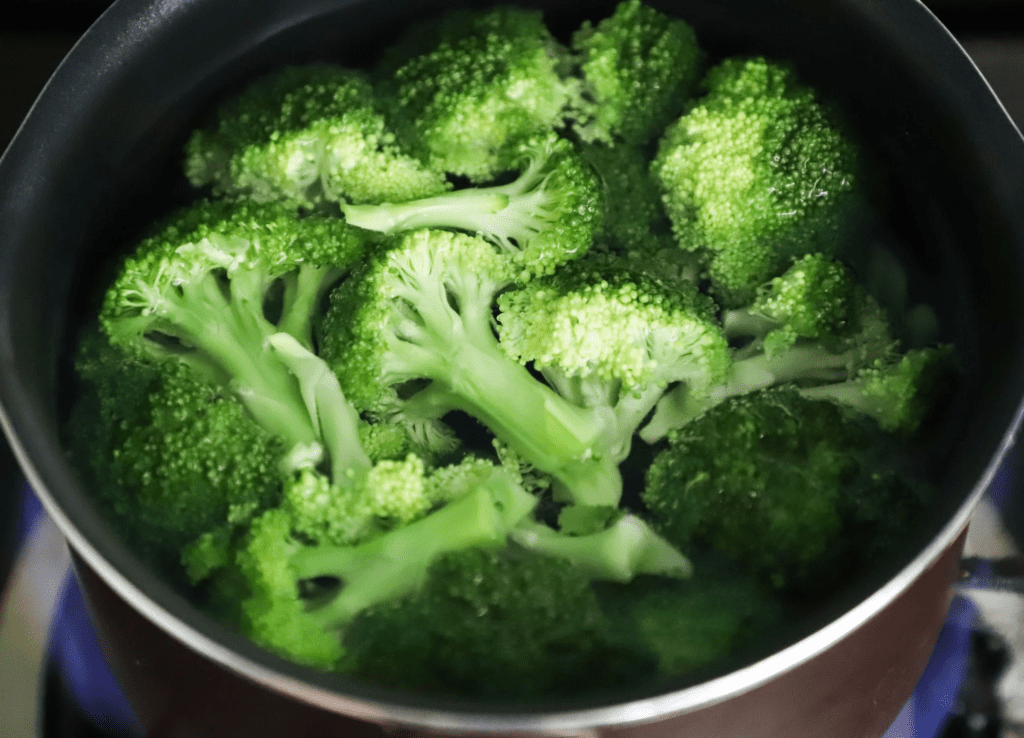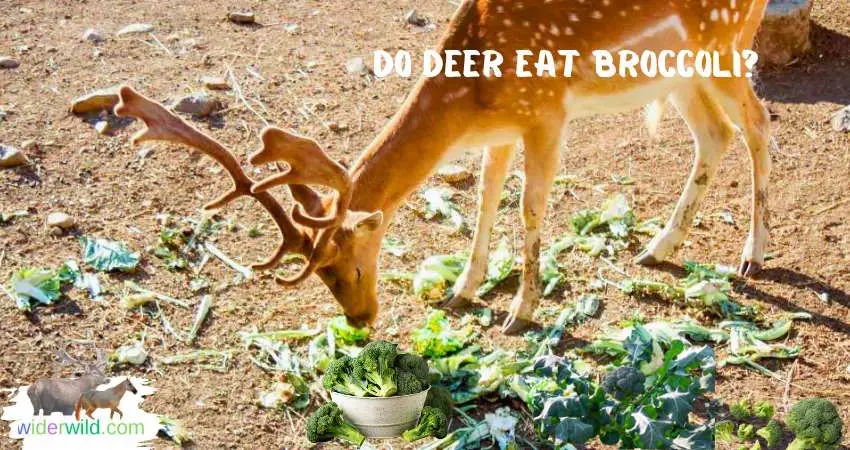Yes, deer eat broccoli. These grazing animals have been known to consume broccoli plants.
Deer are herbivorous mammals and are known to have a varied diet, which includes a wide range of vegetation.
Broccoli is not an exception, and it falls under the category of plant material that deer will feed on. Deer are opportunistic eaters and will often munch on whatever is available.
Their diet primarily consists of leaves, twigs, fruits, and grasses, but they may also nibble on crops and garden plants, including broccoli.
Nevertheless, it’s important to note that deer preferences can vary depending on their natural habitat and other available food sources. So while deer may eat broccoli, it doesn’t necessarily mean they will actively seek it out as a preferred food source.
Factors That Influence Deer Feeding Habits

Deer feeding habits are influenced by various factors, including food availability, seasonality, and plant palatability.
Whether deer eat broccoli depends on these factors, with some deer showing a preference for it while others may not. These influences can help in predicting deer feeding patterns and managing their habitats effectively.
Deer are beautiful creatures that populate many areas, including forests, meadows, and even suburban neighborhoods. Their feeding habits play a crucial role in their survival and overall well-being.
The factors that influence deer feeding habits can help us coexist with these animals and make informed decisions when it comes to managing their populations. In this article, we will explore some key factors that influence deer feeding habits.
Natural Food Sources
Deer primarily rely on natural vegetation for their sustenance. They have evolved to consume a wide range of plants, shrubs, herbs, and even tree bark. The availability of natural food sources greatly impacts deer feeding habits.
Types Of Vegetation Deer Prefer
Deer have their preferences when it comes to the types of vegetation they consume. They tend to prefer tender leaves and shoots, especially of plants such as clover, alfalfa, and young saplings. These plants provide the necessary nutrients and energy required for deer to thrive.
Availability Of Different Food Sources Throughout The Year
Throughout the year, the availability of food sources for deer can vary. They adapt their feeding habits accordingly to survive during periods of scarcity.
For example, in the spring and summer months, when vegetation is abundant, deer have a wider range of options. In contrast, during winter, when food is scarce, they may resort to feeding on woody browse and other less desirable plants.
Seasonal Changes In Deer Diet
Deer exhibit seasonal changes in their diet due to the availability of different food sources. During the spring and summer months, they consume a lot of fresh green vegetation rich in proteins and minerals.
In the fall, they shift their focus to high-energy foods such as acorns and nuts to prepare for the upcoming winter. Understanding these seasonal changes can help us better manage deer habitats and populations.
Human Influence
Human activities have a significant impact on deer feeding habits. As human development encroaches upon natural habitats, deer must adapt to eating a more artificial diet.
This can include grazing on lawns, crops, and even ornamental plants in suburban areas. Human influence on deer feeding habits is an important consideration when developing wildlife management strategies.
Impact Of Human Development On Deer Behavior
The increasing presence of humans and their structures can disrupt deer behavior and feeding patterns. Deer may become more nocturnal, altering their feeding habits to avoid encounters with humans.
This can result in a different distribution of deer populations and changes in the types of plants they consume in human-populated areas.
Nutritional Factors In Human-managed Lands
Deer in human-managed lands may encounter nutritional factors that differ from their natural habitats.
Grazing on manicured lawns or farmlands provides different nutrient profiles compared to wild vegetation. These nutritional factors are crucial to ensuring the well-being of deer in human-altered ecosystems.
Deer Adaptation To Human-populated Areas
Deer have shown remarkable adaptability to human-populated areas. They have learned to exploit available food sources in urban environments, such as gardens, parks, and green spaces.
The strategies deer use to survive in these areas can help us minimize conflicts and create more harmonious interactions between humans and wildlife.
Numerous factors influence deer feeding habits. Understanding these factors is vital for effective wildlife management, especially in areas with human development.
By considering natural food sources, vegetation preferences, seasonal changes in the diet, human influence, and the impact of human development and nutritional factors, we can ensure the well-being of deer populations and promote coexistence with these graceful animals.
The Nutritional Value Of Broccoli For Deer
Broccoli is a highly nutritious food that deer can eat. It provides essential vitamins and minerals to support their overall health and well-being.
Nutritional Content Of Broccoli
When it comes to the nutritional needs of deer, the importance of a well-balanced diet cannot be understated. Broccoli, a cruciferous vegetable, offers a wealth of nutrients that can contribute to the overall health of these magnificent creatures.
Let’s take a closer look at the nutritional content of broccoli and its benefits for deer.
Vitamins And Minerals Found In Broccoli
Broccoli is a nutritional powerhouse, packed with essential vitamins and minerals.
This green vegetable is particularly rich in:
- Vitamin C: Boosts the immune system and promotes healing
- Vitamin K: Helps with blood clotting and bone health
- Vitamin A: Supports vision and reproductive health
- Folate: Essential for DNA synthesis and cell growth
- Potassium: Regulates fluid balance and muscle contractions
- Calcium: Builds strong bones and assists with muscle function
Protein And Fiber Content
In addition to vitamins and minerals, broccoli also contains protein and fiber, which are crucial for deer’s overall well-being.
Protein is essential for muscle development and repair, while fiber aids in digestion and promotes a healthy gut. Incorporating broccoli into their diet ensures that deer receive these vital nutrients.
Comparing Broccoli To Other Vegetation In Terms Of Nutritional Value
When comparing broccoli to other vegetation commonly found in the natural habitat of deer, it becomes evident why they are attracted to this green cruciferous vegetable.
The nutritional value of broccoli exceeds that of many other plants, making it an excellent choice for deer seeking a nutrient-dense meal.
Preference For Broccoli
Deer shows a natural preference for broccoli, primarily due to its taste and texture. The appealing combination of crispness and mild, slightly sweet flavor makes broccoli a favorite amongst these herbivores.
Their fondness for this vegetable further emphasizes its importance as a supplementary food source.
Attraction To The Taste And Texture
Deer are known for their selective grazing habits, and the taste and texture of food play a crucial role in their dietary choices. Broccoli’s unique taste and crunchy texture pique their interest, making it a tempting treat in their foraging endeavors.
Broccoli As A Supplementary Food Source
While deer primarily rely on native vegetation, supplementing their diet with broccoli can provide added nutrition. Broccoli serves as an excellent alternative food source, particularly during times when their natural forage may be limited.
It ensures a diverse diet and helps fill any nutritional gaps, promoting optimal health for these graceful animals.
Environmental Factors That Influence Deer Grazing On Broccoli
Several environmental factors influence the extent to which deer graze on broccoli. Availability and accessibility of the vegetable, competition for resources, and the surrounding vegetation all contribute to their decision to include broccoli in their diet.
By understanding these factors, we can better appreciate the role of broccoli as a nutritional resource for deer.
Impact Of Deer Feeding On Broccoli Farms
Deer feeding can have a significant impact on broccoli farms, leading to economic implications, crop damage, financial losses, and the need for implementing deterrents or preventive measures.
With their voracious appetites and ability to cause extensive damage, deer pose a threat to the profitability and sustainability of broccoli farms.
Economic Implications
Deer feeding can have detrimental economic implications for broccoli farms. The damage caused by deer can result in a reduced yield, lower quality produce, and increased costs for farmers.
With decreased productivity and compromised quality, the profitability of broccoli farms is compromised. This can ripple effect on the entire industry, leading to higher prices for consumers and reduced competitiveness in the market.
Crop Damage And Financial Losses
The crop damage caused by deer feeding can result in significant financial losses for broccoli farmers. Deer tend to target young broccoli plants, which are highly vulnerable and easily damaged.
They can strip the leaves and stems, leaving behind devastated crops. The loss of crops not only affects the current season but can also have long-term consequences, as farmers may need to recover and replant the affected areas, incurring additional costs.
Cost Of Implementing Deterrents Or Preventive Measures
Implementing deterrents or preventive measures to protect broccoli farms from deer damage can be costly. Farmers often need to invest in various methods and technologies to address the issue effectively.
This can include the installation of physical barriers, the application of repellents, or even resorting to hunting and culling.
These measures come with their costs, which farmers must bear. The financial burden of these preventive measures can further impact the profitability of broccoli farms.
Strategies To Control Deer Damage
When it comes to controlling deer damage on broccoli farms, several strategies can be employed. Farmers have found success with the following approaches:
Physical barriers
One effective strategy is the use of physical barriers to prevent deer from accessing the broccoli crops. Farmers can install fences, netting, or electric fencing around their fields to create a barrier that deters deer from entering.
These physical barriers can be highly effective in protecting crops but require proper installation and maintenance to ensure their efficacy.
Repellents and deterrents
Another approach to controlling deer damage is the use of repellents and deterrents. These products are designed to discourage deer from feeding on the broccoli plants.
The market offers a variety of options, including sprays, powders, or granules that emit odors or tastes that deer find unappealing. While the effectiveness of these products may vary, they can provide an additional layer of protection for broccoli farms.
Hunting and culling
In some cases, hunting and culling may be necessary to manage the deer population and reduce crop damage.
This strategy involves responsible hunting practices or authorized culling programs to control the deer population. By reducing the number of deer in the area, farmers can minimize the risk of deer feeding on their broccoli farms. Such practices comply with local regulations and laws.
The impact of deer feeding on broccoli farms can be significant, resulting in economic implications, crop damage, financial losses, and the need for preventive measures.
Farmers need to implement strategies such as physical barriers, repellents, and deterrents, as well as consider responsible hunting practices or authorized culling programs to protect their crops from deer damage and preserve the profitability of broccoli farms.
Coexistence And Conservation Efforts
When it comes to the relationship between deer and broccoli, finding a balance between their populations and agricultural needs is crucial.
Sustainable deer management techniques, wildlife corridors, education, and responsible practices play a pivotal role in preserving these majestic creatures while safeguarding farmlands.
Balancing Deer Populations And Agriculture
As deer populations continue to grow, it becomes essential to develop strategies that enable coexistence with agricultural practices.
Through careful management, farmers can protect their crops while allowing deer to roam freely in their natural habitats. This balance ensures that both deer and farmers can thrive harmoniously.
Sustainable Techniques For Deer Management
Implementing sustainable techniques is vital for maintaining a healthy ecosystem and ensuring the well-being of deer and other wildlife species.
These techniques involve the use of non-lethal methods, such as the installation of fencing, repellents, and deterrents to protect crops, minimizing the need for drastic actions like culling or hunting.
Wildlife Corridors And Protected Areas
Building wildlife corridors and establishing protected areas are effective measures to enable the safe movement of deer and other wildlife between different habitats.
These corridors provide a network of connected landscapes, allowing animals to access food, water, and shelter, thereby reducing conflicts with human activities.
The Role Of Education And Awareness
Education and awareness campaigns are instrumental in promoting understanding and empathy between farmers and wildlife enthusiasts.
By providing information about the importance of deer conservation and the impact of agricultural practices, these initiatives encourage communities to take collaborative action toward coexistence.
Promoting Understanding Between Farmers And Wildlife Enthusiasts
To foster a sense of understanding and empathy, it is crucial to facilitate dialogue between farmers and wildlife enthusiasts.
Open communication channels, such as community meetings and forums, can provide a platform for sharing experiences, concerns, and insights. By building relationships based on mutual respect, both parties can work together to find sustainable solutions.
Encouraging Responsible Deer Management Practices
Promoting responsible deer management practices is key to safeguarding the interests of both farmers and wildlife.
This includes the responsible management of deer populations through non-lethal methods whenever possible, monitoring population levels, and implementing targeted interventions if necessary.
By taking a proactive and responsible approach, the long-term coexistence of deer and agriculture can be achieved.
Coexisting with deer while protecting agricultural interests requires a multifaceted approach that encompasses sustainable deer management, wildlife corridors, education, and responsible practices.
By ensuring the coexistence of deer and agriculture, we can preserve the biodiversity of our ecosystems and promote a harmonious relationship between humans and wildlife.
Frequently Asked Questions For Do Deer Eat Broccoli
What Vegetables Do Deer Not Eat?
Deer typically avoid eating vegetables such as onions, garlic, leeks, and chives due to their strong smell and taste. Additionally, they tend to stay away from plants with prickly leaves like tomatoes, peppers, and cucumbers.
What Animal Eats Broccoli In The Wild?
In the wild, rabbits are known to eat broccoli.
Is It OK to Feed Deer Vegetables?
Yes, it is OK to feed deer vegetables. However, it’s important to remember that they should be given in small quantities and as part of a balanced diet.
Can You Feed Deer Carrots?
Yes, deer can eat carrots. They are a safe and nutritious food source for them.
Do Deer Eat Broccoli In The Wild?
Yes, deer will eat broccoli if it is available in their natural habitat.
Is Broccoli A Part Of A Deer’s Natural Diet?
While broccoli is not a staple in a deer’s natural diet, they will consume it if given the chance.
What Other Vegetables Do Deer Eat Besides Broccoli?
Deer commonly eat vegetables such as carrots, peas, potatoes, and beets in addition to broccoli.
Final Words
The evidence suggests that deer do indeed have a taste for broccoli. Considering their browsing behavior and the nutritional value of this vegetable, it’s likely they would indulge in it if given the opportunity.
So, if you’re a gardener or farmer, it’s important to take precautions to protect your broccoli crops from these hungry creatures.
By implementing deterrents and creating barriers, you can minimize the chances of deer wreaking havoc on your beloved broccoli plants. Start safeguarding your crops today!
Read Related Post on Deer Diet and Feeding Habits:

